Before the 21st century hipster passion for inking made tattooing commonplace in Western societies, the painted body was long regarded as a great curiosity.
As early as the 1580s, John White recorded with ethnographic precision the tattoos of Algonquian people of North America around the English settlement at Roanoke, North Carolina, as well as drawing fanciful watercolours of woaddecorated ancient Picts. In 1691 the buccaneer explorer William Dampier brought back to Britain an extensively patterned Sulawesi youth, Jeoly; as ‘Prince Gioli’ he was profitably ‘shown for a sight’ before succumbing to smallpox. The following century saw the great age of Pacific exploration, with expeditions by Samuel Wallis and Philip Carteret, the Comte de Bougainville, James Cook and the Comte de la Pérouse. Sydney Parkinson’s published journal of Cook’s first voyage included images of Tahitian and New Zealand faces ‘curiously tataow’d or mark’d, according to their Manner’, while the navigators’ crews brought the techniques of Polynesian tattooing into common naval usage.
In 1820 the Ngāpuhi chief Hongi Hika and his nephew Ruapara visited England from New Zealand on a mission to secure arms for the internecine Musket Wars; they were followed by Te Pāhi Kupe (Tupai Cupa) in 1826. The facial moko of both chiefs were the source of as much astonishment as admiration, and the latter had his portrait painted by Liverpool artist John Sylvester. From the 1820s through to mid-century, the intensity and intimacy of Māori moko were still sufficiently remarkable in Europe that ‘Pakeha–Māori’ such as John Rutherford and Barnet Burns were able to sustain a living by exhibiting themselves.
According to his own account, Rutherford was born in Manchester around 1796 and went to sea as a boy of 10, serving on both Royal Navy and merchant vessels in the Atlantic, the East Indies and the Pacific. Rutherford describes how, in 1816, while on the east coast of the North Island of New Zealand on the American brig Agnes, the ship was captured by Māori and its captain and eight crew killed and eaten. The narrative continues with a description of tattooing, of his life amongst the tribe of a chief named Aimy, marriage to Aimy’s two daughters, journeys along the coast and into the interior, and his eventual rescue by another American brig in January 1826. From as early as 1842, however, the facts of Rutherford’s story have been widely challenged, and it seems more likely that he was simply a runaway sailor ‘adopted’ by Māori for some years. Making his way home via Tahiti, Sydney and Rio de Janeiro, Rutherford returned to England in 1828, where he published his sensational story and showed himself in ‘a travelling caravan of wonders’. Having announced his intention to return to the Pacific, he disappears from the historical record around 1830.
Dempsey’s watercolour, possibly taken when Rutherford was working in London in early 1829, certainly shows him as something of an opportunist, or at least an improviser. Not only does he have the resource of an exotic appearance in the moko of his face and exposed forearm, but that same arm also supports a street vendor’s basket, full of roasted hazelnuts. At the same time, his right hand holds another potential money-spinner, a circular gambling spinning wheel. Dempsey wittily conflates the wide boy’s face and fortune, with the divisions of the gaming board dial echoing the radiating ti-ti lines on Rutherford’s forehead.
Collection: National Library of New Zealand, Wellington

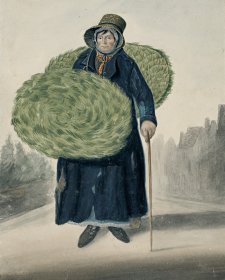

Dempsey’s People curator David Hansen chronicles a research tale replete with serendipity, adventure and Tasmanian tigers.
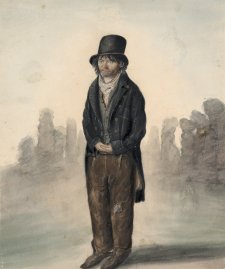
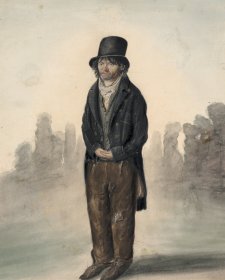
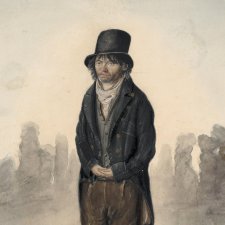
30 June 2017
Those of you who are active in social media circles may be aware that through the past week I have unleashed a blitz on Facebook and Instagram in connection with our new winter exhibition Dempsey’s People: A Folio of British Street Portraits, 1824−1844.

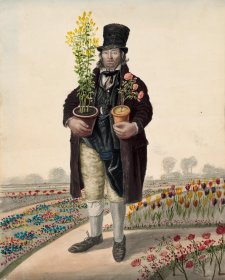

Dempsey’s people: a folio of British street portraits 1824–1844 is the first exhibition to showcase the compelling watercolour images of English street people made by the itinerant English painter John Dempsey throughout the first half of the nineteenth century.